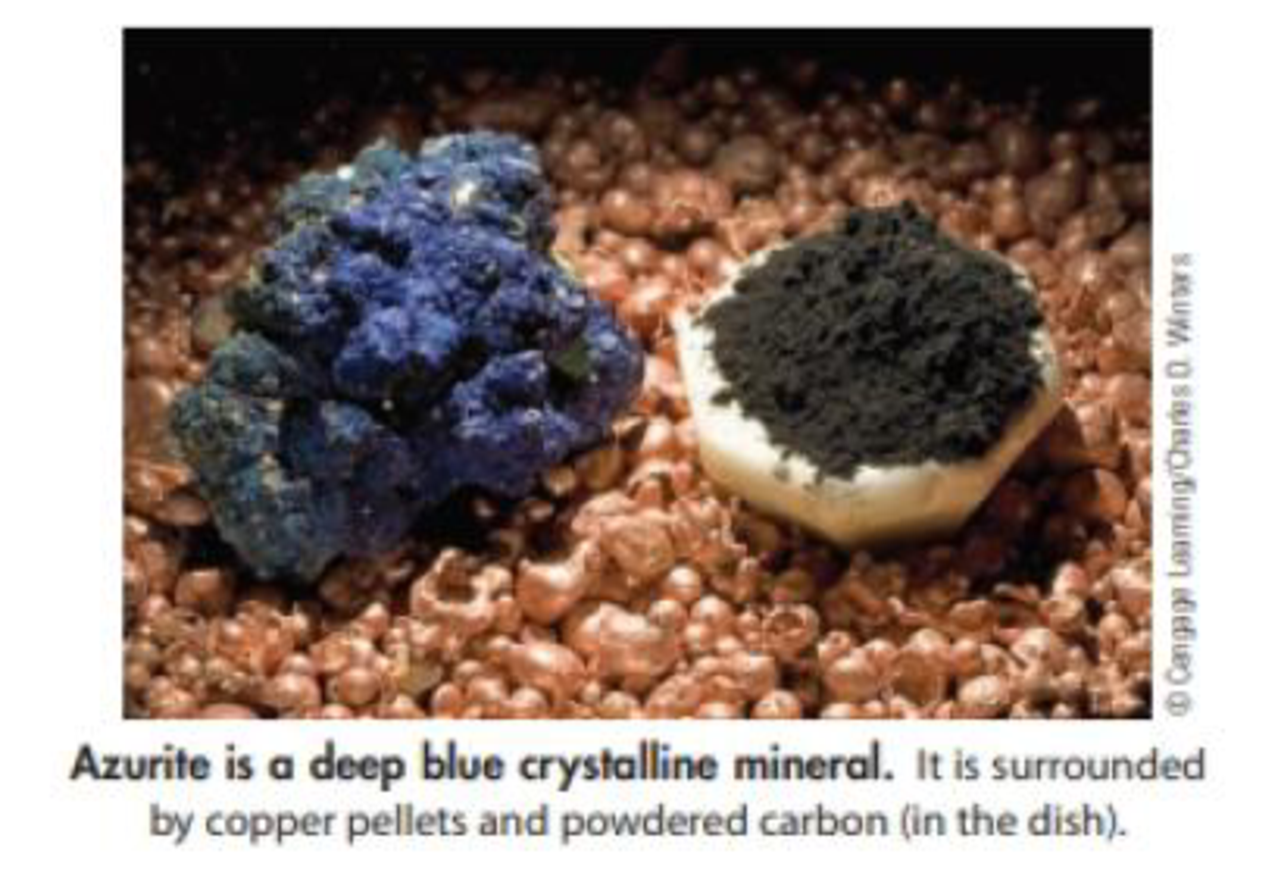
OWLv2 6-Months Printed Access Card for Kotz/Treichel/Townsend's Chemistry & Chemical Reactivity, 9th, 9th Edition
9th Edition
ISBN: 9781285460680
Author: Kotz, Treichel, Townsend
Publisher: Cengage Learning
expand_more
expand_more
format_list_bulleted
Concept explainers
Textbook Question
Chapter 1, Problem 30GQ
Azurite, a blue, crystalline mineral, is composed of copper, carbon, and oxygen.

(a) What are the symbols of the three elements that combine to make the mineral azurite?
(b) Based on the photo, describe some of the physical properties of the elements and the mineral. Are any the same? Are any properties different?
Expert Solution & Answer
Trending nowThis is a popular solution!

Students have asked these similar questions
Construct a molecular orbital diagram for carbon monoxide. Identify the relevant point group,include all of the appropriate symmetry labels and pictures, and fill in the electrons. Make sure toaccount for the difference in electronegativity between C and O. Hint: CO is substantiallyisoelectronic to N2. (PLEASE DRAW THE ENTIRE MO DIAGRAM!!!)
please help with hw
help me solve this hw
Chapter 1 Solutions
OWLv2 6-Months Printed Access Card for Kotz/Treichel/Townsend's Chemistry & Chemical Reactivity, 9th, 9th Edition
Ch. 1.5 - Prob. 1.1CYUCh. 1.6 - Prob. 1.2CYUCh. 1.6 - Identify whether each of the following properties...Ch. 1.7 - Identify whether each of the following is a...Ch. 1.8 - Much has been written about CO2.What is its name?Ch. 1.8 - Prob. 1.2ACPCh. 1.8 - Prob. 1.3ACPCh. 1.8 - The spines of the sea urchin, corals, and...Ch. 1 - In the following scenario, identify which of the...Ch. 1 - State whether the following is a hypothesis,...
Ch. 1 - What is meant by the phrase sustainable...Ch. 1 - Prob. 4PSCh. 1 - Prob. 5PSCh. 1 - Prob. 6PSCh. 1 - Give the name of each of the following elements:...Ch. 1 - Give the name of each of the following elements:...Ch. 1 - Give the symbol for each of the following...Ch. 1 - Give the symbol for each of the following...Ch. 1 - In each of the following pairs, decide which is an...Ch. 1 - In each of the following pairs, decide which is an...Ch. 1 - An 18 g sample of water is decomposed into 2 g of...Ch. 1 - A sample of the compound magnesium oxide is...Ch. 1 - In each case, decide if the underlined property is...Ch. 1 - In each case, decide if the change is a chemical...Ch. 1 - Which part of the description of a compound or...Ch. 1 - Which part of the description of a compound or...Ch. 1 - The flashlight in the photo does not use...Ch. 1 - A solar panel is pictured in the photo. When light...Ch. 1 - Determine which of the following represent...Ch. 1 - Prob. 22PSCh. 1 - A hot metal block is plunged into water in a...Ch. 1 - A book is held at a height above the floor. It has...Ch. 1 - Prob. 25GQCh. 1 - Iron pyrite (fool's gold, page 11) has a shiny...Ch. 1 - Which observations below describe chemical...Ch. 1 - Which observations below describe chemical...Ch. 1 - The mineral fluorite contains the elements calcium...Ch. 1 - Azurite, a blue, crystalline mineral, is composed...Ch. 1 - You have a solution of NaCI dissolved in water....Ch. 1 - Small chips of iron are mixed with sand (see...Ch. 1 - Identify the following as either physical changes...Ch. 1 - Identify the following as either physical changes...Ch. 1 - In Figure 1.2 you see a piece of salt and a...Ch. 1 - In Figure 1.5 you see macroscopic and particulate...Ch. 1 - Prob. 37GQCh. 1 - The following photo shows copper balls, immersed...Ch. 1 - Categorize each of the following as an element, a...Ch. 1 - Categorize each of the following as an element, a...Ch. 1 - Make a drawing, based on the kinetic-molecular...Ch. 1 - Make a drawing, based on the kinetic-molecular...Ch. 1 - Hexane (C6H14, density = 0.766 g/cm3),...Ch. 1 - You have a sample of a white crystalline substance...Ch. 1 - You can figure out whether a solid floats or sinks...Ch. 1 - You are given a sample of a silvery metal. What...Ch. 1 - Milk in a glass bottle was placed in the freezing...Ch. 1 - Describe an experimental method that can be used...Ch. 1 - Diabetes can alter the density of urine, so urine...Ch. 1 - Prob. 50GQCh. 1 - The following photo shows the element potassium...Ch. 1 - Prob. 52GQCh. 1 - Four balloons are each filled with a different...Ch. 1 - Prob. 54GQCh. 1 - The photo below shows elemental iodine dissolving...Ch. 1 - A few years ago a young chemist in Vienna,...Ch. 1 - The distance between two carbon atoms in diamond...Ch. 1 - A student checked the accuracy of two standard...Ch. 1 - Prob. 3RCYUCh. 1 - The density of gold is 19,320 kg/m3. What is this...Ch. 1 - A particular paint has a density of 0.914 g/cm3....Ch. 1 - What is the fuel density in units of kg/L?Ch. 1 - What mass and what volume of fuel should have been...Ch. 1 - Confirm that a person swimming at the world record...Ch. 1 - At this world record rate, how long would it take...Ch. 1 - Prob. 2.3RACh. 1 - Many laboratories use 25C as a standard...Ch. 1 - The temperature on the surface of the Sun is 5.5 ...Ch. 1 - Prob. 3RPSCh. 1 - Make the following temperature conversions:Ch. 1 - A marathon distance race covers distance of 42.195...Ch. 1 - The average lead pencil, new and unused, is 19 cm...Ch. 1 - A standard U.S. postage stamp is 2.5 cm long and...Ch. 1 - A compact disc has a diameter of 11.8 cm. What is...Ch. 1 - A typical laboratory beaker has a volume of 250....Ch. 1 - Some soft drinks are sold in bottles with a volume...Ch. 1 - A book has a mass of 2.52 kg. What is this mass in...Ch. 1 - A new U.S. dime has a mass of 2.265 g. What is its...Ch. 1 - Ethylene glycol, C2H6O2, is an ingredient of...Ch. 1 - A piece of silver metal has a mass of 2.365 g. If...Ch. 1 - Prob. 15RPSCh. 1 - Which occupies a larger volume, 600 g of water...Ch. 1 - You are on a diet that calls for eating no more...Ch. 1 - A 2-in. piece of chocolate cake with frosting...Ch. 1 - Prob. 19RPSCh. 1 - Prob. 20RPSCh. 1 - You and your lab partner are asked to determine...Ch. 1 - The accepted value of the melting point of...Ch. 1 - Prob. 23RPSCh. 1 - Prob. 24RPSCh. 1 - Prob. 25RPSCh. 1 - Prob. 26RPSCh. 1 - To determine the average mass of a popcorn kernel,...Ch. 1 - Use the following graph to answer the following...Ch. 1 - Use the graph below to answer the following...Ch. 1 - Solve the following equation for the unknown...Ch. 1 - Solve the following equation for the unknown...Ch. 1 - Solve the following equation for the unknown...Ch. 1 - Prob. 34RPSCh. 1 - Molecular distances are usually given in...Ch. 1 - The separation between carbon atoms in diamond is...Ch. 1 - A red blood cell has a diameter of 7.5 m...Ch. 1 - The platinum-containing cancer drug cisplatin...Ch. 1 - Prob. 39RGQCh. 1 - You need a cube of aluminum with a mass of 7.6 g....Ch. 1 - You have a 250.0-mL graduated cylinder containing...Ch. 1 - Prob. 42RGQCh. 1 - The smallest repeating unit of a crystal of common...Ch. 1 - Diamond has a density of 3.513 g/cm3. The mass of...Ch. 1 - Prob. 45RGQCh. 1 - The density of pure water at various temperatures...Ch. 1 - Prob. 47RGQCh. 1 - The aluminum in a package containing 75 ft2 of...Ch. 1 - Fluoridation of city water supplies has been...Ch. 1 - About two centuries ago, Benjamin Franklin showed...Ch. 1 - Prob. 51RGQCh. 1 - A 26-meter-tall statue of Buddha in Tibet is...Ch. 1 - At 25 C, the density of water is 0.997 g/cm3,...Ch. 1 - Suppose your bedroom is 18 ft long and 15 ft wide,...Ch. 1 - A spherical steel ball has a mass of 3.475 g and a...Ch. 1 - You are asked to identify an unknown liquid that...Ch. 1 - You have an irregularly shaped piece of an unknown...Ch. 1 - There are five hydrocarbon compounds (compounds of...Ch. 1 - Suppose you have a cylindrical glass tube with a...Ch. 1 - Copper: Copper has a density of 8.96 g/cm3 An...Ch. 1 - Copper: (a) Suppose you have a cube of copper...Ch. 1 - You set out to determine the density of lead in...Ch. 1 - A sample of unknown metal is placed in a graduated...Ch. 1 - Iron pyrite is often called fool's gold because it...Ch. 1 - You can analyze for a copper compound in water...Ch. 1 - Prob. 67RIL
Additional Science Textbook Solutions
Find more solutions based on key concepts
Single penny tossed 20 times and counting heads and tails: Probability (prediction): _______/20 heads ________/...
Laboratory Manual For Human Anatomy & Physiology
Label each statement about the polynucleotide ATGGCG as true or false. The polynucleotide has six nucleotides. ...
General, Organic, and Biological Chemistry - 4th edition
What were the major microbiological interests of Martinus Beijerinck and Sergei Winogradsky? It can be said tha...
Brock Biology of Microorganisms (15th Edition)
2. Which of the following is the best example of the use of a referent? _
a. A red bicycle
b. Big as a dump tru...
Physical Science
Knowledge Booster
Learn more about
Need a deep-dive on the concept behind this application? Look no further. Learn more about this topic, chemistry and related others by exploring similar questions and additional content below.Similar questions
- Briefly explain chemical potential.arrow_forwardReason whether it is possible to determine changes in the Galvani potential difference at the metal-solution interface.arrow_forwardObtain the standard potential at 25°C of the Cu* I Cu | Pt electrode from the standard potentials E° Cu²+/Cu = 0.341 V and E Cu²+ /Cu+ = 0.153 V.arrow_forward
arrow_back_ios
SEE MORE QUESTIONS
arrow_forward_ios
Recommended textbooks for you
 World of Chemistry, 3rd editionChemistryISBN:9781133109655Author:Steven S. Zumdahl, Susan L. Zumdahl, Donald J. DeCostePublisher:Brooks / Cole / Cengage Learning
World of Chemistry, 3rd editionChemistryISBN:9781133109655Author:Steven S. Zumdahl, Susan L. Zumdahl, Donald J. DeCostePublisher:Brooks / Cole / Cengage Learning Introductory Chemistry: An Active Learning Approa...ChemistryISBN:9781305079250Author:Mark S. Cracolice, Ed PetersPublisher:Cengage Learning
Introductory Chemistry: An Active Learning Approa...ChemistryISBN:9781305079250Author:Mark S. Cracolice, Ed PetersPublisher:Cengage Learning Introductory Chemistry: A FoundationChemistryISBN:9781337399425Author:Steven S. Zumdahl, Donald J. DeCostePublisher:Cengage Learning
Introductory Chemistry: A FoundationChemistryISBN:9781337399425Author:Steven S. Zumdahl, Donald J. DeCostePublisher:Cengage Learning Chemistry: The Molecular ScienceChemistryISBN:9781285199047Author:John W. Moore, Conrad L. StanitskiPublisher:Cengage Learning
Chemistry: The Molecular ScienceChemistryISBN:9781285199047Author:John W. Moore, Conrad L. StanitskiPublisher:Cengage Learning Chemistry & Chemical ReactivityChemistryISBN:9781337399074Author:John C. Kotz, Paul M. Treichel, John Townsend, David TreichelPublisher:Cengage Learning
Chemistry & Chemical ReactivityChemistryISBN:9781337399074Author:John C. Kotz, Paul M. Treichel, John Townsend, David TreichelPublisher:Cengage Learning Chemistry & Chemical ReactivityChemistryISBN:9781133949640Author:John C. Kotz, Paul M. Treichel, John Townsend, David TreichelPublisher:Cengage Learning
Chemistry & Chemical ReactivityChemistryISBN:9781133949640Author:John C. Kotz, Paul M. Treichel, John Townsend, David TreichelPublisher:Cengage Learning

World of Chemistry, 3rd edition
Chemistry
ISBN:9781133109655
Author:Steven S. Zumdahl, Susan L. Zumdahl, Donald J. DeCoste
Publisher:Brooks / Cole / Cengage Learning

Introductory Chemistry: An Active Learning Approa...
Chemistry
ISBN:9781305079250
Author:Mark S. Cracolice, Ed Peters
Publisher:Cengage Learning

Introductory Chemistry: A Foundation
Chemistry
ISBN:9781337399425
Author:Steven S. Zumdahl, Donald J. DeCoste
Publisher:Cengage Learning

Chemistry: The Molecular Science
Chemistry
ISBN:9781285199047
Author:John W. Moore, Conrad L. Stanitski
Publisher:Cengage Learning

Chemistry & Chemical Reactivity
Chemistry
ISBN:9781337399074
Author:John C. Kotz, Paul M. Treichel, John Townsend, David Treichel
Publisher:Cengage Learning

Chemistry & Chemical Reactivity
Chemistry
ISBN:9781133949640
Author:John C. Kotz, Paul M. Treichel, John Townsend, David Treichel
Publisher:Cengage Learning
Types of Matter: Elements, Compounds and Mixtures; Author: Professor Dave Explains;https://www.youtube.com/watch?v=dggHWvFJ8Xs;License: Standard YouTube License, CC-BY